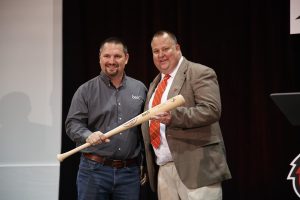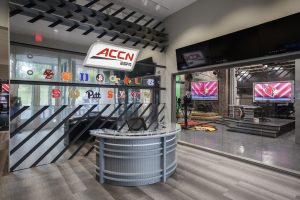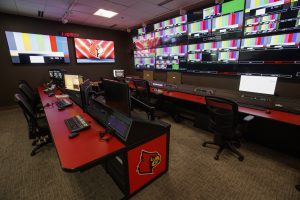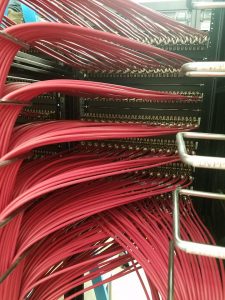With ACC Network on Horizon, University of Louisville Recruits BeckTV for New Broadcast Center Build
Mix of fiber and a mobile unit connects 13 venues to the facility
Story Highlights
The University of Louisville is the latest ACC school to nail down preparations for the upcoming launch of the ACC Network. Some, notably Duke and the University of Pittsburgh, have made substantial changes to their facilities. The Cardinals, however, took it to the next level, constructing a brand-new facility formally named the University of Louisville Athletics Broadcast Center on the far northeast side of campus. In addition to exceeding ESPN’s requirements for the network, the structure lived up to the university’s expectations as well.

BeckTV’s Paul Nijak (left) and University of Louisville’s Jeremy Noe at the grand opening of the UofL Broadcast Center
“The cool thing about this project is, what I came up with two years ago when I woke up and drew it on a piece of paper is what we built,” says Executive Director, ACC Network Operations, Jeremy Noe. “We went from being one of the last schools to come to the party to the third one ready, to the third one doing linear shows.”
A Plethora of Planning
Before the first move toward making the university’s vision a reality, Noe did his due diligence and researched all the specifics. To see what other schools were doing, he trekked to other control rooms instead of discussing the matter over the phone.
“If they were within a four- to five-hour driving radius from me, I went and visited them,” he explains. “I asked the same questions: What did you do that you liked? If you had to do it over, what would you do differently? I knew what I needed to ask from day one because I did my homework.”
The reason for taking time to lay out his plan was twofold. Primarily, the school wanted to get the most for its expenditure. “I knew what they did at Notre Dame with the IP-based [infrastructure], and I knew that I didn’t want to do IP-based because of the scope of what we do,” Noe says. “I wanted to maximize my dollar so, instead of [being able to say], ‘We’re IP-based,’ I wanted to be able to get all the cool toys and gadgets with the dollar amount I had.”
More important, he had only one attempt at getting the control room right. “I had the chance to do this once and one time only. I can’t go back and say, ‘Oh, I forgot this.’”
Approval From the State Legislature
After getting some help from Anthony James Partners (AJP) as the primary consultant for the procurement process, Noe sought a systems integrator that matched his work ethic. After he did even more research, the university selected BeckTV, and that company’s senior engineer, Paul Nijak, signed on to take the lead.
“[Beck’s] philosophy on the partnership and becoming part of the family is why I went with them,” Noe says. “I knew their work; I knew they did a lot of TV-production trucks, and that’s what I’m used to. [Paul and I] work well together. It had to be a unique person that knew how to work well with me: he knew when to tell me something I needed to know, but he also let me be involved as much as he was allowed to.”
Although both parties were ready to get the project started in late 2017, Noe and his team hit a bump in the road with the state legislature. “We actually had to go to Frankfurt and ask to spend our own money because it wasn’t part of our initial two-year plan. Even though we were self-funded, we needed to have approval to build on state property,” he says. “We were held up until Jan. 1.”
Actual construction began in February and concluded in time for the grand opening on Labor Day weekend.
The Nuts and Bolts
The $8 million, 7,850-sq.-ft. broadcast center houses four separate control rooms and a wide range of equipment. As at other ACC schools, BeckTV installed an Evertz DreamCatcher replay system and EQX router and four Ross XPression graphics packages (two for each linear control room). Besides studio programming, Ross XPression will also power the in-venue videoboard. Other Ross products include a Carbonite Black 3M/E video switcher and a Tria video server. When it comes to sound, Beck integrated Yamaha CL5 audio boards to handle the job.
For production, Noe purchased a total of 28 cameras. Inside the broadcast center, the team has 10 Ikegami 99c cameras with Canon lenses: four with 80X, two with 14X2 wide angles, and the rest with 24X ENG standard. Tripods for these cameras were supplied by Vinten. Other specialty cams include three Marshall POV kits, nine Sony BRCH800 robos, and a wireless RF from Wave Central.
With an already hectic schedule, including an increase from 80 studio shows a year to 176, Noe needs to be able to cover all athletic events at once. The biggest technical transformation, an expansive fiber network both inside the facility and to 12 of 13 venues, makes that job possible. The team uses more than 38.6 miles of wiring to connect the in-house equipment. For productions outside the building, 576 strands connect Cardinal Stadium (football), Dr. Mark & Cindy Lynn Stadium (soccer), Jim Patterson Stadium (baseball), Ulmer Field (softball), and other venues on campus.
The KFC Yum! Center, home to men’s and women’s basketball, is the only venue not connected to the fibered infrastructure. Located in downtown Louisville, the arena is a state-run building. According to Noe, the team will begin pulling fiber from the location two weeks into the basketball season. Until then, a 26-ft. mobile unit owned by the university will be producing games on the hardwood.
In addition to fiber connection, the team is staying verbally connected with the help of RTS Intercom Systems. With 26 Roameo wireless beltpacks, the connection is able to reach reporters conducting live hits in the parking lot during football telecasts.
If You Build It, They Will Come
The broadcast center is primed to be the new centerpiece in player recruitment, according to Noe. “It’s game-changing in terms of closing in on a recruit: we can give you national exposure right here. Also, it’s a big financial game-changer for us, and we understand that revenue is going to come from it.”
The project was a blend of the existing foundation of the university and the birth of a new era in University of Louisville athletics. “To do what we need to do for launch [of the ACC Network], we’re more than ready,” he notes. “It’s amazing because we built on schedule and on budget. That’s one thing about Louisville: when we build, we do it right.”
CLICK HERE to check out more SVG coverage of ACC Network Launch Day.



